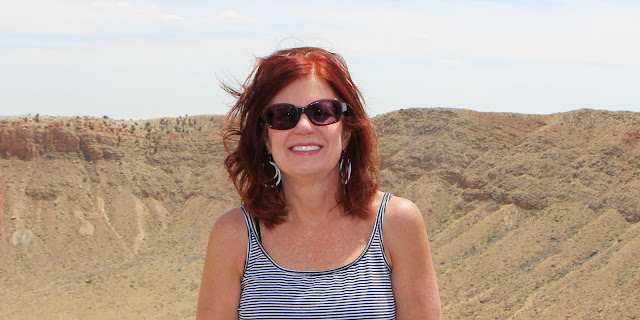 |
| Petrified Forest National Park |
 |
| Vermilion Cliffs looking flat |
Arizona Meteor Crater,
My next stop was a place I thought would be a bit cheesy, but was actually interesting. The Arizona Meteor Crater, near Winslow, is said to be the "best preserved meteorite crater on Earth."
It is a private enterprise and costs $18 to visit. There is a guided (short) tour, museum and film.
 |
| The Visitor Center/Museum sits on the edge |
Despite its importance as a geological site, the crater is not protected as a National Monument, but it is a National Natural Landmark.
Meteor Crater is at an elevation of about 5,710 ft., is about 3,900 ft. in diameter, 570 ft. deep and is surrounded by a rim that rises 148 ft. above the surrounding plains.
 |
| Very impressive in person |
The site was formerly known as the Canyon Diablo Crater and fragments of the meteorite are officially called the Canyon Diablo Meteorite. Scientists refer to the crater as Barringer Crater in honor of Daniel Barringer, who was first to suggest that it was produced by meteorite impact. Before that, it was assumed to be a volcanic crater.
 |
| Remnants from old nickel mining operations |
The crater was created about 50,000 years ago during the Pleistocene Epoch, when the local climate was much cooler and damper. The area was an open grassland dotted with woodlands inhabited by woolly mammoths and giant ground sloths.
 |
| Illustration: NASA |
 |
| Aerial view: Arizona Meteor Crater |
 |
| And, humans are still looking |
The rugged terrain in the area has been used by NASA for Astronaut training. I saw my friend Leroy Chiao's name on a plaque commemorating Astronauts who have trained there.
 |
| Displays |
Petrified Forest National Park
Then, on to Petrified Forest National Park, which covers about 146 square miles of semi-desert shrub steppe and colorful badlands and is along the historic Route 66.
It is filled with a staggering number of petrified trees from the Late Triassic Period, about 225 million years ago. Even though I had been there years ago, I was surprised at how many trees were there.
 |
| They are everywhere, especially on the north side of the Park |
Over 200 million years ago, logs were quickly buried in an ancient river system under massive amounts of sediment, cutting off oxygen. Minerals, including silica from volcanic ash, absorbed into the porous wood over thousands of years crystallized, replacing the organic material with beautifully colored quartz.
 |
| Amazing colors |
There are two types of petrified wood -- some still contains wood embedded in stone and some is pure quartz.
There are logs and trees that look as if they were sawed into pieces, but actually cracked as they settled.
 |
| You can really see the tree-ness in this one |
Petrified Forest is part of the colorful Chinle Formation, from which the Painted Desert gets its name.
 |
| Painted desert |
Beginning about 60 million years ago, tectonic forces pushed up the Colorado Plateau, exposing it to increased erosion.
All of the park's rock layers above the Chinle have been removed by wind and water.
 |
| Severely eroded |
In addition to petrified logs, fossils found in the park include Late Triassic ferns, cycads, ginkgoes and other plants as well giant reptiles called phytosaurs, large amphibians and early dinosaurs.
 |
| Little critters still live here |
It was a hot, windy day, but I did some hiking. It is very other-worldly.
 |
| Such an interesting (and unforgiving) landscape |
The only wildlife I saw was a Jack Rabbit on the move ...
 |
| I am amazed that I saw it (enlarged on the right) |
... and a Pronghorn ...
 |
| A common sight in lands where you think nothing could survive |
The park's earliest human inhabitants arrived at least 8,000 years ago. By about 2,000 years ago, they were growing corn in the area and shortly thereafter building pit houses. Later inhabitants built pueblos, which they abandoned because of climate changes. More than 600 archeological sites, including petroglyphs, have been discovered in the park. This is Newspaper Rock.
 |
| "Newspaper Rock" is a common name for petroglyphs like this |
In the 16th century, Spanish explorers visited the area and by the mid-19th century a U.S. team had surveyed an east--west route through the area.
 |
| Note: The New Yorker |
The site was declared a National Monument in 1906 and a National Park in 1962.
Theft of petrified wood remains a problem in the 21st century. And, apparently, based on how much is sent back, it can bring bad luck to the thief (whether it be misfortune or arrest and fine).
Unlike many parks, it closes in the evening. So, I stayed until the end of the day (8:00 p.m.) and then drove to Gallup, New Mexico, for the night.
Trip Date: June 7-13, 2014


No comments:
Post a Comment